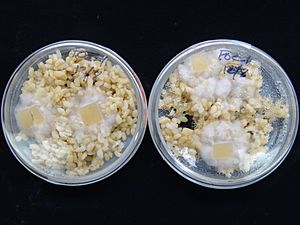Fusarium oxysporum f.sp. cubense facts for kids
Quick facts for kids Fusarium oxysporum f.sp. cubense |
|
|---|---|
 |
|
| Fusarium oxysporum f.sp. cubense race 1 growing for several days on brown rice | |
| Scientific classification |
|
| Kingdom: | Fungi |
| Division: | Ascomycota |
| Class: | Sordariomycetes |
| Order: | Hypocreales |
| Family: | Nectriaceae |
| Genus: | Fusarium |
| Species: |
F. oxysporum
|
| Subspecies: |
F. o. f.sp. cubense
|
| Trinomial name | |
| Fusarium oxysporum f.sp. cubense E.F.Sm., W.C.Snyder & H.N.Hansen (1940)
|
|
| Synonyms | |
|
|
Fusarium oxysporum f. sp. cubense is a tiny fungus that causes a serious plant sickness called Panama disease in banana plants. This disease is also known as fusarium wilt of banana.
This fungus puts a lot of pressure on places where bananas are grown. It can destroy many important types of bananas. This makes it hard for farmers to grow and sell their crops.
Contents
What is Fusarium oxysporum?
Fusarium oxysporum is a type of fungus often found in soil. It makes three kinds of tiny spores. These spores help the fungus spread and survive.
The first type is called macroconidia. These spores are long and thin. They usually have three or four sections. They help spread the infection to new parts of the plant.
The second type is microconidia. These spores are oval-shaped. They have one section or no sections at all. Like macroconidia, they are important for spreading the infection.
The third type is chlamydospores. These spores are round and have thick walls. They can live in the soil for a very long time. They are the main way the disease starts in new plants. These tough spores are the most important for the fungus to survive. They are usually found on dead or dying banana plants.
How the Disease Spreads
The Foc fungus spreads mainly in a few ways. Rain can splash tiny bits of the fungus from one plant to another. Moving soil that has the fungus in it also spreads the disease. This can happen when people move soil or when water washes it around.
Another big way it spreads is through infected banana plant parts. If farmers use parts from a sick plant to grow new ones, the disease will spread. Wind alone does not seem to spread the fungus. Animals might carry the fungus on their bodies, but it's not clear if they can spread the disease effectively.
This fungus is a soil-borne pathogen. This means it lives in the soil. It can infect living banana plants even after 20 years without any banana plants around. This is because the tough chlamydospores can survive for a very long time. The fungus can also stay hidden inside plants without showing symptoms for a while.
How the Fungus Infects Bananas
When the fungus is near a banana plant, its spores start to grow. Spores grow faster when they are near banana roots that are easy to infect. This means that if a banana plant is strong and resistant, its roots might stop the spores from growing. This is how some banana plants can fight off the disease.
The fungus quickly gets inside the root cells of the banana plant. Once inside, it starts to cause damage.
Different Types of Foc
Scientists have found four main types, or "races," of this fungus. Each race attacks different kinds of banana plants.
- Race 1: This race attacked a banana type called 'Gros Michel'. It caused a huge disease outbreak in the 1900s. It also attacks other types like 'Ducasse' and 'Lady Finger'.
- Race 2: This race attacks a banana type called 'Bluggoe' and its close relatives.
- Race 3: This race attacks Heliconia plants. These are ornamental flowers, not bananas. This race is now called Fusarium oxysporum f. sp. heliconiae.
- Race 4: This race attacks 'Dwarf Cavendish' bananas. It also attacks all the banana types that Race 1 and Race 2 infect.
Tropical Race 4 (TR4)
| Fusarium odoratissimum | |
|---|---|
| Scientific classification | |
| Genus: |
Fusarium
|
| Species: |
odoratissimum
|
| Synonyms | |
|
Foc strain TR4 |
|
Tropical Race 4, or TR4, is a very serious type of the fungus. It can infect all banana types that Race 1 and Race 2 can infect. Since 2019, some scientists have started to call this specific type Fusarium odoratissimum.
Subtropical Race 4 (STR4)
Subtropical Race 4, or STR4, is another type of Race 4. It usually only causes sickness in 'Cavendish' bananas when the plants are stressed. For example, cold weather can make the plants sick. This type has also been found in weeds like Paspalum and Amaranthus in Australia. These weeds might help spread the fungus.
Research and Solutions
Many scientists are working hard to find ways to control Panama disease. It is very important to find effective methods to stop the disease. Researchers are also trying to breed new types of banana plants that can resist the fungus.
Scientists are studying the fungus's genes. They want to understand how it changes and how different types of the fungus are related. This research helps them learn how the disease spreads and how it has changed over time.
One study looked at how different types of F. oxysporum that cause banana wilt are related. The results showed that these types did not all come from one common ancestor. Instead, they seem to have developed the ability to infect bananas independently. This means the fungus found ways to attack bananas more than once in its history.

